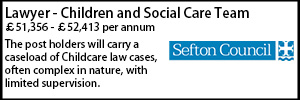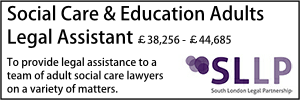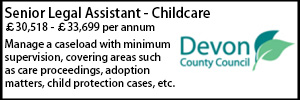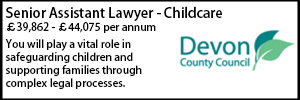Section 117 after-care statutory guidance – a missed opportunity?
- Details
Lee Parkhill reviews new Government guidance on the joint duty under s.117 of the Mental Health Act 1983.
On 26 January 2024, the Department of Health and Social Care issued statutory guidance: ‘Discharge from mental health inpatient settings’ (‘the Guidance’). Annex B to the Guidance seeks to address how the joint duty under s. 117 of the Mental Health Act 1983 should be shared between local authorities and NHS Integrated Care Boards. Confusion as to the discharge of the s. 117 duty is common, and disputes often arise. There is a clear need for guidance. Regrettably, this guidance is unlikely to provide much, if any, assistance to practitioners on how the duty is to be shared.
Section 117 of the Mental Health Act 1983 imposes a duty to provide after-care to patients who have been detained under s. 3 of the Act (or certain other provisions), and then discharged from hospital. The duty is joint, falling on a local authority and an Integrated Care Board.
How the joint duty is to operate in practice can be contentious: does the local authority or the NHS have responsibility for funding any accommodation under s. 117?; should funding of a package simply be split on per centage terms, or should there be an analysis of the costs of particular elements of care?; do principles which generally govern the division between health and social care apply to s. 117?
Some local authorities and ICBs have put in place local arrangements, with a wide range of approaches being adopted. Some areas simply agree to split the costs of s. 117 packages on a fixed per centage. Some areas use a scoring ‘matrix’, akin to the decision support tool for NHS Continuing Healthcare, to arrive at the split to be applied in each case. One might have expected the new statutory guidance to give a clear view as to which, if any, of these approaches should be adopted. Not so.
The main body of the Guidance addresses a number of matters including how local authorities and NHS bodies should work together, and roles and responsibilities within the discharge process. The guidance on discharging the joint s. 117 duty is set out in Appendix B ‘National guidance on how budgets and responsibilities should be shared to pay for section 117 aftercare (Mental Health Act 1983)’ (‘the 117 Guidance’).
The 117 Guidance in Appendix B is long, running to 16 pages. It covers a wide range of topics, some of which are not obviously related to the matter of how ‘budgets and responsibilities should be shared’ (which the title suggests is the focus of the document). For example, the 117 Guidance includes passages on what s. 117 services are, and the principles to guide what should go into a package of s. 117 after-care. There are also sections devoted to the arrangements that should be in place for transition between children’s and adult services, and there is a section addressing how individuals should be discharged from after-care. These are important topics, but they are already covered in the Code of Practice to the 1983 Act and/or the Statutory Care and Support Guidance, and these topics are not obviously related to the matter of how ‘budgets and responsibilities should be shared’.
Where the 117 Guidance does address how the duty might be discharged by local authorities and ICBs, its stops short of articulating any firm guidance. For example, the 117 Guidance advocates the use of s. 75 agreements, but simply suggests that local areas decide what the contributions to any pooled budget should be:
There is no ‘one-size-fits-all approach’, given the variation between systems in terms of the populations they serve and the existing organisations they contain, but areas should consider the mechanisms available for them to deliver integrated section 117 after care arrangements, for example through section 75 NHS Act 2006.
We want to ensure there is flexibility to enable as much collaboration and integration as possible and the government is currently reviewing the legislation underpinning section 75 NHS Act 2006 to see if we should update it to enable further use. Pooling agreements will remain subject to both NHS and local authority leadership within both systems and places agreeing what constitutes a fair and appropriate contribution.’
Local authorities and ICBs might consider this a statement of what is already obvious, providing little assistance to resolve disputes as to what is a fair and appropriate contribution from each agency. It is no satisfactory answer to say that the Secretary of State opposes a one-size-fits-all approach. The s. 117 duty must be the same throughout England (and Wales). There should be no difficulty in providing national guidance as to the principles which govern the joint performance of the duty. Local implementation of the duty might vary, but it cannot be suggested that there can be regional variations in what the duty requires of local authorities and the NHS.
The 117 Guidance goes on to provide a ‘case study’, describing arrangements in Surrey, where the local authority and NHS have agreed to:
‘… to take a shared approach to section 117 funding decisions with 50/50 splits on all new funding agreements’
The 117 Guidance does not address whether, and why, a simple agreement to split all packages 50:50 is appropriate. Accordingly, there is no consideration of whether such a split, in all cases, might risk conflict with s.117B of the 1983 Act. Section 117B provides that s. 117 does ‘not authorise or require a local social services authority, …, to provide or arrange for the provision of nursing care by a registered nurse.’ Where a package of care consists predominantly of nursing care, a 50/50 split might, arguably, contravene s. 117B. The s. 117 Guidance does not refer to s. 117B at all.
The apparent endorsement of a 50:50 split arrangement is also curious given that, in the National Framework for NHS Continuing Healthcare and NHS funded Nursing Care, the Secretary of State suggests that s. 117 funding should be split by reference to the type of services required by the individual. At para. 340, the Framework says:
‘Local policies should be in place dealing with the approach to section 117 which should include apportionment of financial responsibility having regard to the nature of the services being provided.’
A simple 50:50 split, for all cases and regardless of the services being provided, is a very different approach.
The 117 Guidance discusses, at length, the systems which might be employed to support joint decision making by local authorities and NHS bodies. But, unfortunately, (and despite its title), it provides no clear steer as to how ‘budgets… should be shared’ in the sense of how the division of funding should be determined. Practitioners might well consider this to have been a missed opportunity to provide much needed assistance to local authorities and ICBs.
The s. 117 Guidance is statutory guidance, and so should be followed. However, despite its length, the reality is that it sets out little by way of principles, or concrete steps, which organisations could be compelled to follow. Perhaps, in time, the Secretary of State will come to grapple with the principles of how the joint s. 117 duty should be funded. Until then, practitioners will have to continue applying s. 117, s. 117B and the principles which inform the division of health:social care responsibilities.
Lee Parkhill is a barrister at Cornerstone Barristers, specialising in public law in the field of health and social care, and mental capacity law























































